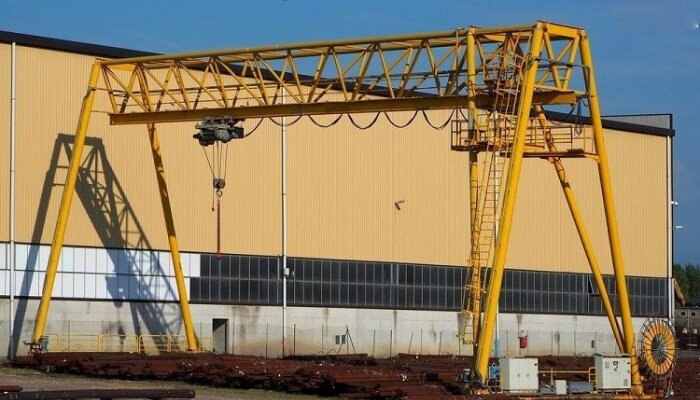According to Zion Market Research, the global gantry crane market was valued at USD 2.1 billion in 2022 and is anticipated to exceed USD 3.6 billion by 2030. This growth is projected to occur at a compound annual growth rate (CAGR) of roughly 6% during the forecast period from 2023 to 2030.
A gantry crane is a type of crane that relies on a framework consisting of two vertical legs and an overhead beam for support. It is commonly utilized in industrial and construction contexts for the purpose of lifting and transporting heavy materials or objects. The legs of a gantry crane are typically mounted on wheels or rails, allowing horizontal movement along a track or across a wide area. The overhead beam, also referred to as the bridge or girder, spans between the legs and accommodates a trolley or hoist mechanism that moves vertically to raise and lower loads. Gantry cranes vary in size and configuration to meet diverse lifting needs, ranging from compact portable models used in workshops to large-scale cranes deployed in shipyards and construction sites.
The global gantry crane market’s growth is primarily driven by the adoption of automation and technological advancements. Automation technologies such as remote control systems, sensors, and advanced software have enabled increased efficiency, precision, and safety in gantry crane operations. Automated gantry cranes come equipped with features like intelligent load sensing, collision avoidance, and real-time monitoring, which enhance productivity and reduce the likelihood of accidents. Additionally, the integration of Internet of Things (IoT) technologies and data analytics into gantry cranes allows for predictive maintenance, optimizing performance, and minimizing downtime. This translates to lower maintenance costs and improved operational efficiency.
The demand for automated gantry cranes is propelled by the advantages they offer, including heightened productivity, enhanced safety, reduced labor expenses, and increased operational flexibility. As industries seek to streamline their processes and maximize productivity, the adoption of automated gantry cranes is anticipated to rise, thereby stimulating market expansion.
However, the gantry crane sector faces growth impediments, with one significant factor being stringent regulatory and safety standards. Gantry cranes are subject to safety regulations imposed by governmental bodies and industry organizations to ensure the well-being of workers, equipment, and the environment. Adhering to these safety standards necessitates additional investments in safety features, training programs, and regular inspections. For instance, gantry cranes may require anti-collision systems, overload protection mechanisms, emergency stop controls, and appropriate warning signage. Implementing these safety measures increases the overall cost of owning and operating gantry cranes.
Amid these challenges, the industry also presents opportunities rooted in the growing emphasis on sustainable and environmentally friendly solutions. As environmental consciousness continues to escalate, there is a rising demand for greener and more energy-efficient equipment across diverse industries. Gantry crane manufacturers can seize the opportunity to develop eco-friendly gantry crane solutions that minimize environmental impact.
Another challenge in the global gantry crane market is the scarcity of skilled labor. Operating and maintaining gantry cranes necessitates trained and skilled personnel. However, certain regions grapple with a dearth of qualified crane operators and maintenance technicians. This scarcity could hinder gantry crane adoption and utilization while driving up labor costs for businesses.
The insights from Zion Market Research offer a comprehensive analysis of the gantry crane market scope, including its market size of USD 2.1 billion in 2022 and the projected expansion to USD 3.6 billion by 2030, growing at a 6% CAGR during 2023-2030. The insights encompass key players like Konecranes, Cargotec Corporation, Liebherr Group, Terex Corporation, and others. The market is categorized based on factors such as type, lifting capacity, application, end-use industry, and region.
The gantry crane market is poised for substantial growth due to automation advancements, while challenges related to safety standards, labor shortages, and the demand for eco-friendly solutions must also be navigated. Nonetheless, the market offers opportunities for innovative solutions, particularly in the context of sustainable equipment development.




































